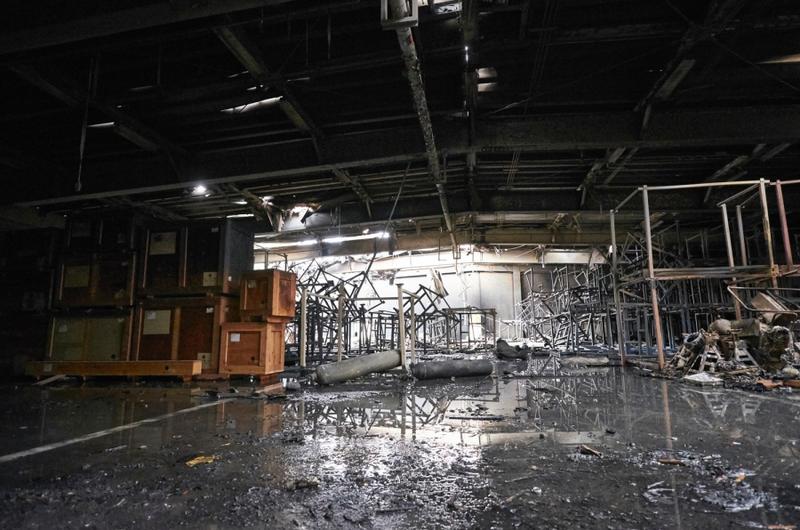

This website was created and maintained from May 2020 to May 2021 to commemorate the 75th anniversary of Stars and Stripes operations in the Pacific.
It will no longer be updated, but we encourage you to explore the site and view content we felt best illustrated Stars and Stripes' continued support of the Pacific theater since 1945.
Explosion rocks US Army facility in Japan; no injuries reported

The interior of Building 163-11, a storage warehouse at Sagami General Depot, that was the site of Monday's early morning explosion at the U.S. Army base in Sagamihara, Japan. Tanks of oxygen, nitrogen, Freon and compressed air exploded around 12:45 am setting the building on fire, but plywood boxes remain in tact with minimal damage.
By Erik Slavin | Stars and Stripes August 23, 2015
TOKYO — A blast at a U.S. Army depot outside Tokyo sparked a fire that burned for hours early Monday and set off secondary explosions. Officials said there were no apparent injuries.
The explosion at Sagami Depot in Kanagawa Prefecture, 34 miles from downtown Tokyo, occurred inside a one-story, concrete warehouse at about 12:45 a.m., Army spokesman Lt. Col. Kevin Toner said.
YouTube vidoes posted by Japanese residents show the explosion shot up fireballs and some fireworkslike blasts that were visible miles away.
The cause of the explosion was not immediately known, Toner said, adding that the building housed tanks of compressed air, nitrogen, oxygen and Freon.
“There are no indications of injuries,” Toner said in an email message. “The building that exploded was not designated as a hazardous material storage facility.”
Sagami Depot does not normally store ammunition or radiological materials, Toner said.
Paint fumes and the smell of charred wood lingered at the building and surrounding area at midday. Debris was mostly contained within 50 yards of the building, although some had been recovered as far as about 300 yards away, according to investigators at the scene.
Inside the building, punctured gas canisters laid strewn around the floor, while plywood boxes on one side appeared blackened by smoke, but otherwise intact. A partially melted phone found in the debris still worked, despite the damage.
Firefighters from a base station a block away arrived soon after the explosion, base officials said.
Sagamihara city’s fire department dispatched 14 trucks and 51 firefighters to the blaze, which smoldered for more than six hours until finally dying out at 7:09 a.m., department spokesman Satomi Kurihara said.
The firefighters did not attempt to extinguish the fire with water, based on the judgment of U.S. military officials at the scene, who were uncertain about what materials the building might have contained, Kurihara said.
The fire posed no threat to nearby structures, Kurihara said.
Aerial footage on Japan’s NHK television showed a broad warehouse with a large section missing from the roof. The NHK camera zoomed in on what appeared to be a small, blackened cylindrical object lying on grass outside of the building.
The building’s walls remain intact, but the windows and doors sustained damage, Toner said.
Sagami is a roughly 500-acre property located near Sagamihara Station. There were no reports of the fire spreading beyond the base. The fire happened 550 yards from the depot fence line, Kurihara said.
The depot is mostly unoccupied and intended to house soldiers, hospital staff, munitions and other equipment in the event of a wartime mass deployment, military officials at the scene said Monday.
About 500 Japanese and 300 Americans work there, base officials said. The depot is about seven miles from Camp Zama, home to thousands of U.S. soldiers and Japan Self-Defense Forces personnel.
In July, Army officials said the U.S. had returned 42 acres of Sagami Depot to Japan last year that had been used for Army family housing.
Another 86 acres have been earmarked for joint use by the U.S. and Japanese governments since 2012, Toner said last month.


